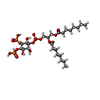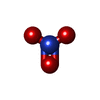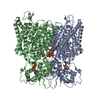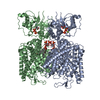+Search query
-Structure paper
| Title | Molecular mechanism underlying regulation of Arabidopsis CLCa transporter by nucleotides and phospholipids. |
|---|---|
| Journal, issue, pages | Nat Commun, Vol. 14, Issue 1, Page 4879, Year 2023 |
| Publish date | Aug 12, 2023 |
 Authors Authors | Zhao Yang / Xue Zhang / Shiwei Ye / Jingtao Zheng / Xiaowei Huang / Fang Yu / Zhenguo Chen / Shiqing Cai / Peng Zhang /  |
| PubMed Abstract | Chloride channels (CLCs) transport anion across membrane to regulate ion homeostasis and acidification of intracellular organelles, and are divided into anion channels and anion/proton antiporters. ...Chloride channels (CLCs) transport anion across membrane to regulate ion homeostasis and acidification of intracellular organelles, and are divided into anion channels and anion/proton antiporters. Arabidopsis thaliana CLCa (AtCLCa) transporter localizes to the tonoplast which imports NO and to a less extent Cl from cytoplasm. The activity of AtCLCa and many other CLCs is regulated by nucleotides and phospholipids, however, the molecular mechanism remains unclear. Here we determine the cryo-EM structures of AtCLCa bound with NO and Cl, respectively. Both structures are captured in ATP and PI(4,5)P bound conformation. Structural and electrophysiological analyses reveal a previously unidentified N-terminal β-hairpin that is stabilized by ATP binding to block the anion transport pathway, thereby inhibiting the AtCLCa activity. While AMP loses the inhibition capacity due to lack of the β/γ- phosphates required for β-hairpin stabilization. This well explains how AtCLCa senses the ATP/AMP status to regulate the physiological nitrogen-carbon balance. Our data further show that PI(4,5)P or PI(3,5)P binds to the AtCLCa dimer interface and occupies the proton-exit pathway, which may help to understand the inhibition of AtCLCa by phospholipids to facilitate guard cell vacuole acidification and stomatal closure. In a word, our work suggests the regulatory mechanism of AtCLCa by nucleotides and phospholipids under certain physiological scenarios and provides new insights for future study of CLCs. |
 External links External links |  Nat Commun / Nat Commun /  PubMed:37573431 / PubMed:37573431 /  PubMed Central PubMed Central |
| Methods | EM (single particle) |
| Resolution | 2.96 - 3.16 Å |
| Structure data | EMDB-35299, PDB-8iab: EMDB-35300, PDB-8iad: |
| Chemicals |  ChemComp-ATP:  ChemComp-MG:  ChemComp-PIO:  ChemComp-CL:  ChemComp-NO3: |
| Source |
|
 Keywords Keywords | MEMBRANE PROTEIN / Transporter / ATP / PIP2 |
 Movie
Movie Controller
Controller Structure viewers
Structure viewers About Yorodumi Papers
About Yorodumi Papers








